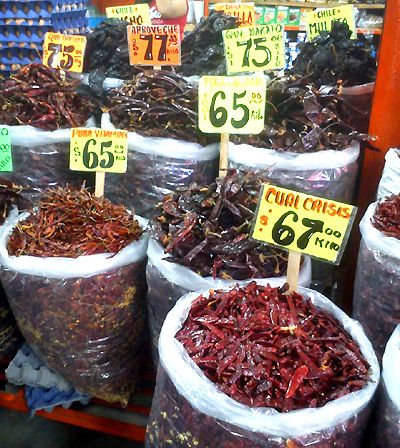

 Dried pappers in the municipal market of Huitzuco, Guerrero; copyright free image courtesy of "Ix kimiaranda" made available through Wikimedia Commons.
Dried pappers in the municipal market of Huitzuco, Guerrero; copyright free image courtesy of "Ix kimiaranda" made available through Wikimedia Commons.Here we're talking about red peppers, not black pepper. Red peppers, which are green before they ripen, are native to the Americas. Black pepper, of salt-and-pepper fame, is completely unrelated, and native to tropical Asia. Red peppers belong to the Nightshade Family. Some red peppers turn black upon drying, but, technically, they're still red peppers.
In most Mexican mercados it's possible to buy fresh peppers, especially the sweet mangos and hot jalapeños Northerners know about, but most pepper sales are of the dried kind. Walking through the dried-pepper zone makes the eyes water and the nose tingle.
It's amazing how many degrees of hotness -- from not hot at all to mind-bogglingly fiery. It happens that pepper hotness can be measured by the "Scofield Scale." At the right you can see how some common peppers stack up according to their Scofield units.
Moreover, the different peppers have different tastes. If you can maneuver around the hot ones, you can discover a whole universe on new tastes in the not-too-hot varieties. Buy a selection of the larger, sweeter dried peppers, rehydrate them overnight, and taste them. Wonderful!

At the left you see the very hot but truly richly flavored chili pequín. In sauces, soups and such they add a delicious smoky, nutty, citrus flavor. Below, that's chili mora at a market in Xochimilco, Mexico City. This very hot pepper measuring about 5cm long (2 inches) is smoked-dried, resulting in a dark color. It's one of the chipotle peppers often used in hot sauces. In some places it's called chipotle mora. A smaller version of this pepper is the chile morita, with similar features and use, just reaching only about 3cm long (1.2 inch).
To use dried chiles, hydrate them by soaking them a few minutes in warm water. The larger the pepper, the more time is needed. By touch you can judge when they are ready to cut up, liquefy, mash, or whatever is needed for your recipe.
Below, that's a Chilequeso taco discovered and eaten in Puebla. It consists of a rehydrated dried poblano pepper, which is an exceptionally large, not hot but very flavorful chile, roasted and covered with melted Chihuahua cheese, on a hot tortilla.